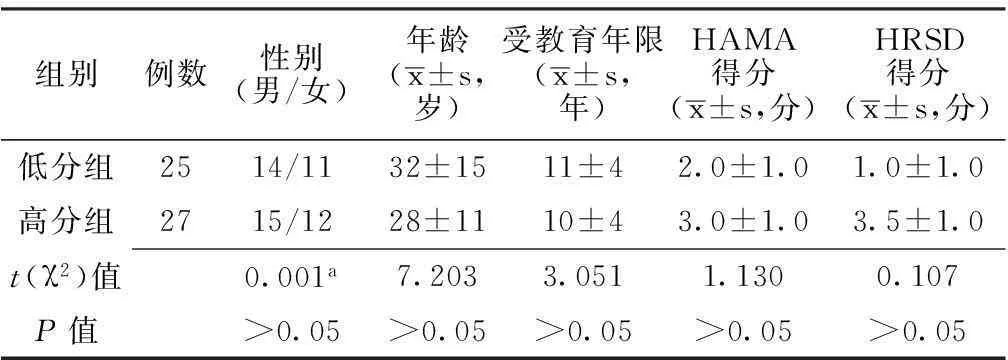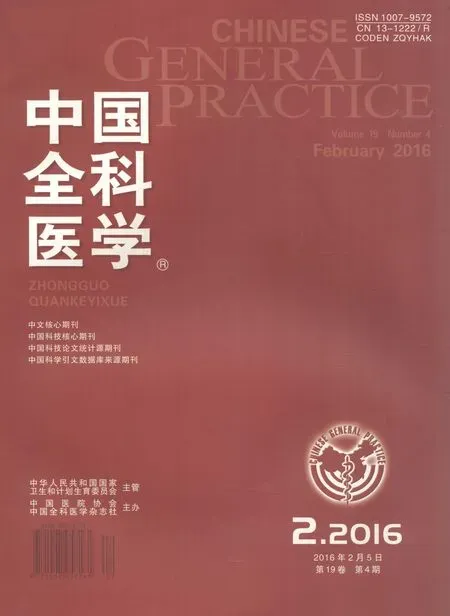个体行为抑制-激活对其风险决策加工策略的影响研究
刘增强,郭宗君,魏 巍,徐圣芬,陈 娟,赤海娇,刘世恩
个体行为抑制-激活对其风险决策加工策略的影响研究
刘增强,郭宗君,魏 巍,徐圣芬,陈 娟,赤海娇,刘世恩
【摘要】目的探讨个体行为抑制-激活(BIS/BAS)对其风险决策加工策略的影响。方法选取2013年1月—2014年10月在青岛大学附属医院进行健康体检的人员347例,根据BIS/BAS量表测评,选取BIS和BAS得分同高、同低各15%的受试者,分别作为BIS/BAS高分组(n=27)和低分组(n=25)。两组均进行高、低风险决策实验,同时记录决策损益、选择偏好和策略模式。结果两组低风险决策条件下保持策略、放弃策略、转换策略得分间差异均无统计学意义(P>0.05);两组高风险决策条件下保持策略、放弃策略、转换策略得分间差异均有统计学意义(P<0.05);两组高风险决策条件下保持策略、放弃策略、转换策略得分与低风险决策条件下比较,差异均有统计学意义(P<0.05)。两组低风险决策条件下损益、选择偏好得分间差异均无统计学意义(P>0.05);两组高风险决策条件下损益、选择偏好得分间差异均有统计学意义(P<0.05);两组高风险决策条件下损益、选择偏好得分与低风险决策条件下比较,差异均有统计学意义(P<0.05)。在低风险决策条件下,BIS得分与选择偏好、保持策略得分均呈正相关(P<0.05),而与转换策略得分呈负相关(P<0.05);BAS得分与保持策略得分呈负相关(P<0.05),而与转换策略得分呈正相关(P<0.05)。在高风险决策条件下,BIS得分与放弃策略得分呈正相关(P<0.05),而与转换策略得分呈负相关(P<0.05);BAS得分与放弃策略得分呈负相关(P<0.05),而与转换策略得分呈正相关(P<0.05)。结论风险规避和获得收益是个体决策的重要机制,随着风险的增加,决策倾向于更加保守和不确定。低风险情况下BIS对个体决策具有更加明显的调控作用,策略稳定性较高;高风险情况下BAS对个体决策具有更加明显的调控作用,表现为更高的策略不稳定性。
【关键词】行为抑制/激活系统;决策;风险;偏好;策略
刘增强,郭宗君,魏巍,等.个体行为抑制-激活对其风险决策加工策略的影响研究[J].中国全科医学,2016,19(4):458-461.[www.chinagp.net]
Liu ZQ,Guo ZJ,Wei W,et al.Behavioral inhibition and activation effect on the risk decision-making process strategy[J].Chinese General Practice,2016,19(4):458-461.
Behavioral Inhibition and Activation Effect on the Risk Decision-making Process StrategyLIUZeng-qiang,GUOZong-jun,WEIWei,etal.DepartmentofGerontology,theAffiliatedHospitalofQingdaoUniversity,Qingdao266003,China
【Abstract】ObjectiveTo investigate the effect of behavioral inhibition/activation system(BIS/BAS) and risk decision-making process strategy.MethodsWe enrolled 347 healthy people who received physical examination in the Affiliated Hospital of Qingdao University from January 2013 to October 2014.According to the evaluation by BIS/BAS scale,we selected the subjects that were among both 15% highest BIS scorers and 15% highest BAS scorers and assigned them into high score group (n=27);we selected subjects that were among both 15% lowest BIS scorers and 15% lowest BAS scorers and assigned them into low score group (n=25).High-risk decision test and low-risk decision test were conducted on both groups,and gain-loss of decision making,choice preference and strategy pattern were also recorded.ResultsThe two groups were not significantly different in the scores of keeping strategy,abandoning strategy and changing strategy under low-risk decision-making condition(P>0.05);the two groups were significantly different in the scores of keeping strategy,abandoning strategy and changing strategy (P<0.05) under high-risk decision-making condition;the scores of keeping strategy,abandoning strategy and changing strategy of the two groups under high-risk decision-making condition were significantly different from those under low-risk decision-making condition (P<0.05).The two groups were not significantly different in the scores of gain-loss and choice preference under low-risk decision-making condition (P>0.05);the two groups were significantly different in the scores of gain-loss and choice preference under high-risk decision-making condition (P<0.05);the scores of gain-loss and choice preference of the two groups under high-risk decision-making condition were significantly different from those under low-risk decision-making condition (P<0.05).Under low-risk decision-making condition,BIS score was positively correlated with the scores of choice preference and keeping strategy (P<0.05),and was negatively correlative with the score of changing strategy(P<0.05);BAS score was negatively correlated with keeping strategy(P<0.05),but was negatively correlated with the score of changing strategy.Under high-risk decision-making condition,BIS score was positively correlated with the score of abandoning strategy(P<0.05),but was negatively correlated with the score of changing strategy (P<0.05);BAS score was negatively correlated with the score of abandoning strategy(P<0.05),but was positively correlated with the score of changing strategy (P<0.05).ConclusionRisk aversion and getting gains are important mechanisms of individual decision,and with the increase of risk,decision-making tends to be more conservative and uncertain.Under low-risk condition,BIS has more significant control effect on individual decision making,with higher strategy stability;under high-risk decision,BAS has more significant control effect on individual decision making,showing higher strategy instability.
【Key words】Behavioral inhibition/activation system;Decision making;Risk;Preference;Strategy
行为抑制(BIS)是对惩罚性刺激、非奖赏刺激敏感。当BIS被激活时,个体常减慢或停止行为[1]。行为激活(BAS)是对奖赏、非惩罚性刺激敏感。当BAS被激活时,常促进个体行为[2]。Suhr等[3]发现BIS得分高且BAS得分低的个体较BIS得分低且BAS得分高的个体在爱荷华赌博任务(IGT)中得分更高。由此可见,由于BIS/BAS的不同,其决策绩效存在差异,推测其决策加工的策略模式亦应存在差异,从而导致行为绩效的差异。因此,探讨不同BIS/BAS类型个体在不同风险决策过程中的策略模式和特点具有重要的意义。本研究旨在探讨BIS与BAS得分同时高、低分组在不同风险决策过程的策略模式。
1对象与方法
1.1研究对象选取2013年1月—2014年10月在青岛大学附属医院进行健康体检的人员347例,其中男180例,女167例。纳入标准:(1)认知功能正常,简易智能状态检查(MMSE)评分均为30分[4];(2)情绪稳定,汉密尔顿焦虑量表(HAMA)分值<7分和汉密尔顿抑郁量表(HRSD)分值<8分[4];(3)汉族;(4)年龄20~55岁;(5)知情同意且能够配合检查。排除标准:(1)既往有心、脑、肝、肾等疾病病史,精神疾病史及精神疾病用药史、家族史;(2)有重大躯体疾病;(3)色盲。
1.2方法
1.2.1BIS/BAS量表测评[5]受试者均进行BIS/BAS量表测评,按BIS、BAS量表得分由高到低排序,选取BIS和BAS得分同高、同低各15%的受试者,分别作为BIS/BAS高分组(n=27)和低分组(n=25)。
1.2.2决策实验决策任务参照Ellsberg[6]和陈娟等[7]的方法并略做修改,采用E-prime编程完成。具体为:电脑屏幕上呈现一个盒子,其内有10张扑克牌,分别由方块和梅花两种花色组成,方块、梅花在盒子内左右随机呈现,并标明各自在盒子内的数量。要求受试者每次是否从盒子中抽方块?抽牌按1键;放弃按4键。抽到方块则得分奖励,没有抽到则扣分。先进行预实验,告知受试者任务要求和得分及奖惩情况,待充分熟悉实验过程后进行正式实验。实验结束后将得分合计折算成人民币付给受试者。其中有2种决策情景:(1)低风险决策:盒子内有6张方块、4张梅花牌,抽中+18分,抽不中-18分,放弃0分;(2)高风险决策:盒子内有2张方块、8张梅花牌,抽中+50分,抽不中-50分,放弃0分。每种决策情景重复10次,电脑自动记录受试者的损益得分、选择模式等。参照文献[4]方法计算选择偏好、策略模式得分等。

2结果
2.1两组一般情况比较两组受试者的MMSE得分均为30分。两组性别、年龄、受教育年限及HAMA、HRSD得分间差异均无统计学意义(P>0.05,见表1),具有可比性。

表1 两组一般情况比较
注:HAMA=汉密尔顿焦虑量表,HRSD=汉密尔顿抑郁量表;a为χ2值
2.2两组不同风险决策条件下保持策略、放弃策略、转换策略得分比较两组低风险决策条件下保持策略、放弃策略、转换策略得分间差异均无统计学意义(P>0.05);两组高风险决策条件下保持策略、放弃策略、转换策略得分间差异均有统计学意义(P<0.05);两组高风险决策条件下保持策略、放弃策略、转换策略得分与低风险决策条件下比较,差异均有统计学意义(P<0.05,见表2)。
2.3两组不同风险决策条件下损益、选择偏好得分比较两组低风险决策条件下损益、选择偏好得分间差异均无统计学意义(P>0.05);两组高风险决策条件下损益、选择偏好得分间差异均有统计学意义(P<0.05);两组高风险决策条件下损益、选择偏好得分与低风险决策条件下比较,差异均有统计学意义(P<0.05,见表3)。

Table 2Comparison of the scores of keeping strategy,abandoning strategy and changing strategy under different risk decision-making conditions between the two groups

组别例数保持策略低风险 高风险放弃策略低风险 高风险转换策略低风险 高风险低分组257.0±2.21.1±0.3a0.8±0.13.9±0.5a1.9±0.44.0±0.4a高分组277.5±1.82.7±0.5a0.2±0.12.3±0.6a1.3±0.32.9±0.3at值0.6844.3131.0522.0121.1122.150P值>0.05<0.01>0.05<0.05>0.05<0.01
注:与低风险比较,aP<0.01

Table 3Comparison of the scores of gain-loss and choice preference under different risk decision-making conditions between the two groups

组别例数损益低风险 高风险选择偏好低风险 高风险低分组2544.6±10.6-100.0±18.7a88.8±2.432.8±4.1a高分组2734.7±10.0-168.5±25.1a91.9±1.958.2±6.2at值0.6842.1641.0153.416P值>0.05<0.01>0.05<0.05
注:与低风险比较,aP<0.01
2.4不同风险决策条件下BIS、BAS得分与损益、选择偏好及各策略模式得分的相关分析低分组BIS、BAS得分分别为(6.1±1.1)、(16.0±5.0)分;高分组BIS、BAS得分分别为(15.3±3.0)、(28.1±8.0)分。在低风险决策条件下,BIS得分与选择偏好、保持策略得分均呈正相关(P<0.05),而与转换策略得分呈负相关(P<0.05);BAS得分与保持策略得分呈负相关(P<0.05),而与转换策略得分呈正相关(P<0.05)。在高风险决策条件下,BIS得分与放弃策略得分呈正相关(P<0.05),而与转换策略得分呈负相关(P<0.05);BAS得分与放弃策略得分呈负相关(P<0.05),而与转换策略得分呈正相关(P<0.05,见表4)。
3讨论
强化敏感理论认为主要有两大机制导致了人格、情绪及行为的个体差异。一是BIS,一是BAS[8]。BIS对惩罚或威胁性刺激敏感,产生回避或退缩行为。BAS系统对奖赏等刺激敏感,产生趋近行为。大量研究显示,BIS/BAS敏感性改变与心理和行为问题有关,如焦虑、抑郁、物质滥用、饮食障碍和人格障碍等[9-11]。有研究发现BAS和BIS都能各自驱动趋近和回避行为,也就是说各自具有产生消极情绪和积极情绪的部分潜能[12]。
表4不同风险决策条件下BIS、BAS得分与损益、选择偏好及各策略模式得分的相关分析(r值)
Table 4Correlation between BIS /BAS scores and gain-loss,choice preference and each strategy mode under different risk decision-making conditions

变量损益选择偏好保持策略放弃策略转换策略低风险 BIS0.0100.299a0.314a-0.074-0.316a BAS-0.085-0.235-0.277a0.1620.255a高风险 BIS-0.005-0.0240.1770.269a-0.628a BAS-0.1040.2020.046-0.361a0.539a
注:BIS=行为抑制,BAS=行为激活
本研究结果显示,两组在低风险决策条件下未发现损益、选择偏好、策略运用方面的差异,但在高风险决策条件损益、选择偏好、策略模式方面均存在差异。在高风险决策(高即时收益、高即时损失)条件下BIS/BAS高分组较低分组具有更高的选择偏好、保持策略,但损益、放弃、转换策略得分均低于低分组。本研究还显示,低风险决策条件下,BIS得分与选择偏好、保持策略得分均呈正相关,而与转换策略得分呈负相关;BAS得分与保持策略得分呈负相关,而与转换策略得分呈正相关。在高风险决策条件下,BIS得分与放弃策略得分呈正相关,而与转换策略得分呈负相关;BAS得分与放弃策略得分呈负相关,而与转换策略得分呈正相关。这些结果表明,BIS和BAS均参与了决策加工判断过程,且具有相互制约和相互影响的作用[13]。但在低风险决策条件下,BIS占有更大的主导作用,个体更多地考虑稳妥和控制损失等因素,采取慎重和稳步的策略模式,保障更多的经济获益。而在高风险决策条件下,BIS和BAS得分同高个体,具有较高的选择偏好和风险倾向,但决策得分并不高,说明高风险条件下BAS占主导的可能性更大,BIS和BAS得分同高个体更多地被风险奖赏性的投机机会因素与即时的高收益因素所吸引,表现为更高的选择偏好和策略保持倾向,较少的放弃和转换策略倾向。Balconi等[14]、Seifert等[15]研究发现BAS高分个体在高即时收益、高即时损失同时并存的情况下更关注高即时收益;Brunborg等[16]研究结果显示BIS高分个体在IGT中具有躲避高风险倾向,在高风险条件下得分更高;van等[17]研究结果显示,与高BAS得分并低BIS得分被试比较,低BAS得分并高BIS得分的被试在IGT中总得分更高,表明在高低风险损益并存的条件下,行为决策同时受到BIS、BAS的影响,且BIS在低风险收益得分方面具有重要作用,而BAS在追求高风险收益方面具有重要作用。本研究结果与之基本一致。
本研究结果还提示同组内低风险比高风险损益、选择偏好得分明显增高,而放弃策略、转换策略得分明显降低,这表明风险规避和获得收益是个体决策加工过程中的重要机制,随着风险的增加,决策倾向于更加保守和不确定。
作者贡献:刘增强、郭宗君进行研究设计与实施、撰写论文、成文并对文章负责;刘增强、魏巍、徐圣芬、陈娟、赤海娇、刘世恩进行研究实施、评估、资料收集;郭宗君进行质量控制与审校。
本文无利益冲突。
参考文献
[1]Gray JA.Brain system that mediate both emotion and cognition[J].Cognition & Emotion,1990,4(3):269-288.
[2]Li YZ,Xu L,Kuang Y,et al.Relationship between cognitive emotion regulation and behavioral inhibition/activation system of adolescents[J].Chinese Journal of Behavioral Medicine and Brain Science,2013,22(1):53-55.(in Chinese)
李彦章,徐立,匡娅,等.青少年认知情绪调节与行为抑制行为激活系统的关系[J].中华行为医学与脑科学杂志,2013,22(1):53-55.
[3]Suhr JA,Tsanadis J.Affect and personality correlates of the Iowa Gambling Task[J].Personality & Individual Differences,2007,43(1):27-36.
[4]徐圣芬,郭宗君,李玉焕,等.抑郁焦虑共病及抑郁症病人决策加工策略研究[J].青岛大学医学院学报,2014,50(6):481-483.
[5]Alloy LB.High behavioral approach system (BAS) sensitivity,reward responsiveness,and goal-striving predict first onset of bipolar spectrum disorders: a prospective behavioral high risk design[J].Journal of Abnormal Psychology,2012,121(2):339-351.
[6]Ellsberg DR.Ambiguity,and the savage axioms[J].Quarterly Journal of Economics,1961,75(4):643-669.
[7]Chen J,Guo ZJ,Liu SE,et al.Analysis of activated brain areas in uncertain rewarding processing of decision making on healthy volunteers[J].Chinese Journal of Behavioral Medicine and Brain Science,2013,22(3):240-242.(in Chinese)
陈娟,郭宗君,刘世恩,等.正常健康者不确定奖赏决策加工过程激活脑区分析[J].中华行为医学与脑科学杂志,2013,22(3):240-242.
[8]Smillie LD,Pickering AD,Jackson CJ.The new reinforcement sensitivity theory: implications for personality measurement[J].Pers Soc Psychol Rev,2006,10(4):320-335.
[9]Balconi M,Falbo L,Conte VA.BIS and BAS correlates with psychophysiological and cortical response systems during aversive and appetitive emotional stimuli processing[J].Motivation & Emotion,2012,36(2):218-231.
[10]Hundt NE,Kimbrel NA,Mitchell JT,et al.High BAS but not low BIS,predicts externalizing symptoms in adults[J].Pets lndivid Differ,2008,44(3):565-575.
[11]Perry JL,Joseph JE,Jiang Y,et al.Prefrontal cortex and drug abuse vulnerability: translation to prevention and treatment interventions[J].Brain Res Rev,2011,65(2):124-149.
[12]Carver CS.Pleasure as a sign you can attend to something else: placing positive feelings within a general model of affect[J].Cognition & Emotion,2003,17(2):241-261
[13]Wardell JD,Read JP,Colder CR.The role of behavioral inhibition and behavioral approach systems in the associations between mood and alcohol consequences in college: a longitudinal multilevel analysis[J].Addict Behav,2013,38(11):2772-2781.
[14]Balconi M,Finocchiaro R,Canavesio Y,et al.Reward bias and lateralization in gambling behavior: behavioral activation system and alpha band analysis[J].Psychiatry Res,2014,219(3):570-576.
[15]Seifert CA,Wulfert E.The effects of realistic reward and risk on simulated gambling behavior[J].Am J Addict,2011,20(2):120-126.
[16]Brunborg GS,Johnsen BH,Pallesen S,et al.The relationship between aversive conditioning and risk-avoidance in gambling[J].J Gambl Stud,2010,26(4):545-559.
[17]van Honk J,Hermans EJ,Putman P,et al.Defective somatic markers in sub-clinical psychopathy[J].Neuroreport,2002,13(8):1025-1027.
(本文编辑:崔沙沙)
(收稿日期:2015-10-02;修回日期:2015-12-26)
【中图分类号】R-055
【文献标识码】A
doi:10.3969/j.issn.1007-9572.2016.04.021
通信作者:郭宗君,266003山东省青岛市,青岛大学附属医院保健科;E-mail:guozjj@163.com
基金项目:山东省科技发展计划项目(2011YD18045);山东省自然科学基金资助项目(ZR2012HM049);山东省保健基金资助项目(2007BZ19);青岛市科技局基金资助项目(Kzd-03、09-1-1-33-nsh、KZJ-28)
作者单位:266003山东省青岛市,青岛大学附属医院保健科(刘增强,郭宗君,魏巍,赤海娇);临沂市平邑县人民医院(徐圣芬);陕西省西安兵器工业五二一医院(陈娟);青岛大学附属医院医学影像科(刘世恩)
·社会·行为·心理 ·

